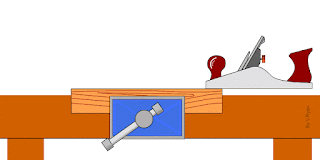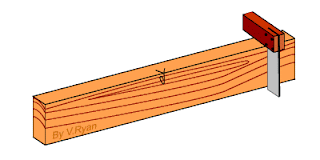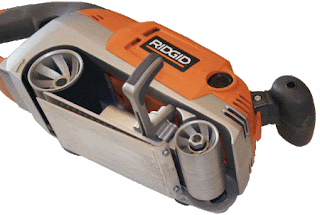sábado, 19 de septiembre de 2015
lunes, 14 de septiembre de 2015
Activity 1
Name: hammer
Uses: directly or
indirectly striking a piece
Name: Wood plane
Uses: They are used
to flatten, reduce the thickness.
Name: Wood file
Uses: to cut fine
amounts of material from a workpiece.
Name: nail set
Uses:
Name: hand saw
Uses: make small cuts
in metal, plastic or wood pieces.
Name: hand drill
Uses: for drilling a
hole size range
Name: bit and brace
Uses: drilling holes
Name: auger bit
Uses: to make holes
Name: flat head
screwdriver
Uses: tightening and loosening
screws
Name: Phillips head
screwdriver
Uses: tightening and
loosening screws
Name: try square
Uses: to mark and
measure a piece of material.
Name: scratch awl
Uses: sew and pierce
leather or timber
Name: standard drill
bit
Uses: creates holes
in various materials
Name: Wood chisel
Uses: forcing a sheet
material to be cut
Name: hot melt glue
gun
Uses: heating element
continuously work to melt the plastic glue
Name: coping saw
Uses: cutting
arbitrary curves
Name: drill press
Uses: drill deep
holes in the ground
Name: wire cutters
Uses: cut through
wires
Name: power hand
drill
Uses: drilling
various materials
Name: power sander
Uses: sanding
different materials
Name: standard pliersUses:
Name: needle nose
pliers
Uses: to bend,
repositioning and cut wire.
Name: vise grips
Uses: can firmly hold
a piece
Name: adjustable
wrench
Uses: tighten screw
elements using screws or nuts
Name: quick grip
clamp
Uses: It is used to
embrace a conduit
Name: C-clamp
Uses: to maintain a
wood or metal workpiece
Name: ball peen
hammer
Uses: forging,
locksmith, metalwork, metalworking
Name: mallet
Uses: Its most common
use is directly hitting the material.
Name: hacksaw
Uses: metal cutting
Name: tin snips
Uses: cut thin metal
sheets
Name: tape measure
Uses: measure
Name: safety glasses
Uses: work with
tools, such as drills or chainsaws
Activity 2
Personal Protective Equipment
1.
Power tools
present more hazards than hand tools due to the speed at which they operate.
There are distinct differences between the PPE suggested for use with hand
tools and the PPE recommended for safe power tool use.
2. Eye protection, such as safety glasses or goggles, is especially important when using
power tools. The speed in which drills, saws, grinders, sanders and routers
operate can propel small particles much faster and farther than do hand tools.
Others working around the area where power tools are used should also wear
protective eyewear. Certain power
tools may require using a face shield, in addition to safety glasses or
goggles. For example, a face shield is recommended while using a grinder, due
to the amount of hot metal particles generated.
3.
Standard cotton
or leather work gloves can protect your hands from minor scrapes and cuts while
working with various materials. Cut-resistant gloves are not designed for, or
capable of providing protection against a moving blade or bit. The best way to
prevent injury from moving parts is to keep your hands on the tools' handles
and keep all guards in place. Anti-vibration gloves minimize the vibration
created by hammerdrills and rotary hammerdrills.
4.
Safety footwear
is recommended when using power tools. Power tools are heavy and can cut you.
Safety shoes with a nonslip, insulated sole and a steel toe protect against
dropped objects and misdirected electricity.
5.
The higher
sound levels generated by some power tools, especially if used over extended
periods of time, may require the use of earplugs or earmuffs. Even the use of a dust respirator may be necessary in
sanding and cutting operations. Each situation must be analyzed to determine
the type of PPE that is required for the safe use of each type of power tool.
6.
Along with PPE,
proper attire is also important while
using power tools. Tie back or cover long hair, wear loose fitting clothes and
remove all jewelry to avoid being caught in moving blades.
7.
Proper Work Practices
8.
Portable power
tools are designed for a wide variety of uses. Circular saws, jig saws, drills,hammer drills, sanders, grinders, routers and numerous other power tools save us time and effort on the
job. The growing popularity of cordless battery-operated tools is putting power tools to use in more places than ever before,
heightening the need for awareness of the dangers they present if not operated
properly. The following safety rules are common to all power tools. In
addition, each type of tool has its own unique hazards, which must be taken
into account.
Questions
a.
What does PPE
stand for? : Recommendations for safe use of the machine
b.
What is the
main difference between power tools and hand tools (paragraph 1)? :
Power tools pose more risk than hand tools due to
the speed at which they operate.
c. What are “safety glasses or goggles” examples of? : Eye protection
power tools are used. For example, a protective mask is recommended when using
a grinder, because the amount of generated hot metal particles.
d. What is the biggest problem when
operating a power tool? Paragraph 2 : generated amount of hot metal particles.
e. Is a face shield a power tool? What
is it? : face shield
f. Why is it advisable to wear a “a face shield” to protect the face from cuts and burns
g. According to paragraph 3. Is it
possible to protect your hands from grinders with gloves? : Yes
h. Why? : As they are cut resistant
gloves are not designed for or capable of providing protection against a blade
or little motion.
i. How can you protect your hand from injures?
: The best way to avoid injury from moving parts is to keep your hands on
the handles of tools' and have all shields in place
j. What do anti-vibration gloves do? : minimize
vibration created by hammer drills rotary hammer drills.
k. Why can power tools cut you? : Power
tools are heavy and may cut
l. How can you prevent foot injuries? :
work boots
m. What characteristics should your
working boots have? : Safety shoes with non-slip, only isolated and
steel toe protection against falling objects and misdirected power.
n. Why should tools operators wear
earplugs in the working area? : because higher sound levels generated by
some power tools
o. What does a “dust respirator” help workers for? : a dust may be
necessary in grinding and cutting operations
Read the
text and then answer the questions below
PORTABLE POWER TOOLS
Personal Protective Equipment
1.
Power tools
present more hazards than hand tools due to the speed at which they operate.
There are distinct differences between the PPE suggested for use with hand
tools and the PPE recommended for safe power tool use.
2. Eye protection, such as safety glasses or goggles, is especially important when using
power tools. The speed in which drills, saws, grinders, sanders and routers
operate can propel small particles much faster and farther than do hand tools.
Others working around the area where power tools are used should also wear
protective eyewear. Certain power
tools may require using a face shield, in addition to safety glasses or
goggles. For example, a face shield is recommended while using a grinder, due
to the amount of hot metal particles generated.
3.
Standard cotton
or leather work gloves can protect your hands from minor scrapes and cuts while
working with various materials. Cut-resistant gloves are not designed for, or
capable of providing protection against a moving blade or bit. The best way to
prevent injury from moving parts is to keep your hands on the tools' handles
and keep all guards in place. Anti-vibration gloves minimize the vibration
created by hammerdrills and rotary hammerdrills.
4.
Safety footwear
is recommended when using power tools. Power tools are heavy and can cut you.
Safety shoes with a nonslip, insulated sole and a steel toe protect against
dropped objects and misdirected electricity.
5.
The higher
sound levels generated by some power tools, especially if used over extended
periods of time, may require the use of earplugs or earmuffs. Even the use of a dust respirator may be necessary in
sanding and cutting operations. Each situation must be analyzed to determine
the type of PPE that is required for the safe use of each type of power tool.
6.
Along with PPE,
proper attire is also important while
using power tools. Tie back or cover long hair, wear loose fitting clothes and
remove all jewelry to avoid being caught in moving blades.
7.
Proper Work Practices
8.
Portable power
tools are designed for a wide variety of uses. Circular saws, jig saws, drills,hammer drills, sanders, grinders, routers and numerous other power tools save us time and effort on the
job. The growing popularity of cordless battery-operated tools is putting power tools to use in more places than ever before,
heightening the need for awareness of the dangers they present if not operated
properly. The following safety rules are common to all power tools. In
addition, each type of tool has its own unique hazards, which must be taken
into account.
Questions
a.
What does PPE
stand for? : Recommendations for safe use of the machine
b.
What is the
main difference between power tools and hand tools (paragraph 1)? :
Power tools pose more risk than hand tools due to
the speed at which they operate.
c. What are “safety glasses or goggles” examples of? : Eye protection
power tools are used. For example, a protective mask is recommended when using
a grinder, because the amount of generated hot metal particles.
d. What is the biggest problem when
operating a power tool? Paragraph 2 : generated amount of hot metal particles.
e. Is a face shield a power tool? What
is it? : face shield
f. Why is it advisable to wear a “a face shield” to protect the face from cuts and burns
g. According to paragraph 3. Is it
possible to protect your hands from grinders with gloves? : Yes
h. Why? : As they are cut resistant
gloves are not designed for or capable of providing protection against a blade
or little motion.
i. How can you protect your hand from injures?
: The best way to avoid injury from moving parts is to keep your hands on
the handles of tools' and have all shields in place
j. What do anti-vibration gloves do? : minimize
vibration created by hammer drills rotary hammer drills.
k. Why can power tools cut you? : Power
tools are heavy and may cut
l. How can you prevent foot injuries? :
work boots
m. What characteristics should your
working boots have? : Safety shoes with non-slip, only isolated and
steel toe protection against falling objects and misdirected power.
n. Why should tools operators wear
earplugs in the working area? : because higher sound levels generated by
some power tools
o. What does a “dust respirator” help workers for? : a dust may be
necessary in grinding and cutting operations
Acivity 3
Name: LUIS EDUARDO GUADUAS RUBIANO date: 15/09/2015 ficha: 974375
Read color
and draw.
A DAY IN THE WORKSHOP
Sebastian is a welder; he is working in a workshop. Sebastian
has to do many things to get a successful job.
For example, he has to wear the uniform properly; he
has to wear a blue overall, orange safety gloves, a black holding mask, brown
safety boots, a yellow hard cap and red ear protectors.
Sebastian has also a routine. Today he has to organize
the tools on the tool board. He has to put the screw driver next to the hammer;
(on the left) the wrench has to be next to the screw driver, on the right of
the hammer he has to put some nails, he has to put a nut between the nails and
the hammer, the pliers have to be below the hammer. He has to put the hacksaw
next to the pliers, on the right. He has to keep the drill in the toolbox and
the jack behind it; some screws and washers have to be on the floor in front of
the toolbox. A try square has to be behind the tool board and finally he has to
put the c-clamp, and the bolt cutter next to the saw blade.
It is a successful day and Sebastian is very happy to
work there.
Suscribirse a:
Entradas (Atom)
































